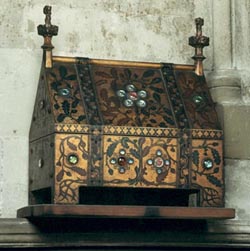 |
The Saint of the Day
St. Etheldreda – June 23
Prof. Plinio Corrêa de Oliveira
Biographical selection:

St. Etheldreda |
Etheldreda was the daughter of Anna, King of East Anglia and the sister of Erconwald, Ethelburga, Sexburga and Withburga, all saints. Etheldreda was born in Exining, Suffolk, and was married at an early age to Tonbert, Prince of the Gyrwe, but they agreed to live in perfect chastity. As part of the marriage settlement, she received from her husband an estate called Ely.
Three years after her marriage, the Prince died, and Etheldreda retired from court and went to live in seclusion on the island of Ely, practicing penance and prayer. For reasons of State she was married again to Egfried, the young son of King Oswiu of Northumbria, who was only 15-years-old. He agreed she should remain a virgin, but 12 years later, demanded his conjugal rights. She refused, saying that she had dedicated herself to God.
She asked the advice of St. Wilfrid, Bishop of Northumbria, who supported her claim and told her to go to a convent. With the consent of Egfried, she became a nun at Codingham Convent. Later, she returned to Ely and built a large double monastery there. She was Abbess of the convent for the rest of her life, and died there on June 23, 695.
Comments of Prof. Plinio:
Here you can see a flash of primitive England and the dawn of the Middle Age that has something of both the savage and the supernatural, creating a contrast of extraordinary beauty. We catch a glimpse of those peoples being born for History.
You should not imagine that St. Etheldreda and her sisters looked like the delicate, fragile daughters of Louis XV, dressed in fine silks and looking like persons made of porcelain. Those ladies were strong, accustomed to cutting wood in the forest, washing their own clothes, and caring for the livestock. At the same time, they were princesses with a great moral stature among those countries that were just coming to light. They were the cradle of future dynasties and their peoples were the starting points of new civilizations.

During the Protestant Revolution St. Etheldreda's incorrupt body was destroyed; only her hand remained. This relic, above, is honored at a small Chapel in Ely |
This explains the grandeur one senses in the ambience surrounding the life of St. Etheldreda, confirmed by the confluence of many saints in her family. It was a court in which four brothers and sisters were saints; another saint, St. Wilfrid, was their spiritual director. This explains why the two Princes who successively married Etheldreda agreed to respect her virginity. Most probably those Princes were men who frequented the Sacraments and, therefore, were in the grace of God. They would not seek relations with any other woman like the unfaithful husbands of our days. Therefore, for them this imposed abstinence was very difficult.
Her life shows an admirable perseverance in purity. She was willing to leave aside her royal advantages and glory to conserve her purity. She left everything to adopt the religious life. Then, she found a convent for nuns and a monastery for monks, the Ely Abbey, which she governed with great wisdom. This represented a lot for the small kingdoms of the time. Her example, influence over, and government of those religious institutions certainly led numerous souls to Heaven.
Let us recommend ourselves to the prayers of St. Etheldreda, who was a seed for the establishment of the Middle Ages. We should ask her to bless us who are fighting for the establishment of another civilization for the glory of God, the Reign of Mary.


  | | Prof. Plinio Corrêa de Oliveira | |
The Saint of the Day features highlights from the lives of saints based on comments made by the late Prof. Plinio Corrêa de Oliveira. Following the example of St. John Bosco who used to make similar talks for the boys of his College, each evening it was Prof. Plinio’s custom to make a short commentary on the lives of the next day’s saint in a meeting for youth in order to encourage them in the practice of virtue and love for the Catholic Church. TIA thought that its readers could profit from these valuable commentaries.
The texts of both the biographical data and the comments come from personal notes taken by Atila S. Guimarães from 1964 to 1995. Given the fact that the source is a personal notebook, it is possible that at times the biographic notes transcribed here will not rigorously follow the original text read by Prof. Plinio. The commentaries have also been adapted and translated for TIA’s site.
|
Saint of the Day | Home | Books | CDs | Search | Contact Us | Donate

© 2002- Tradition in Action, Inc. All Rights Reserved
|
 |

|